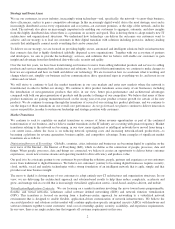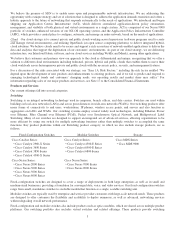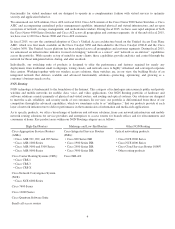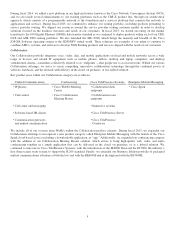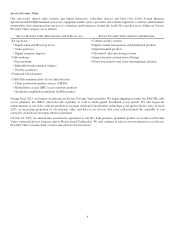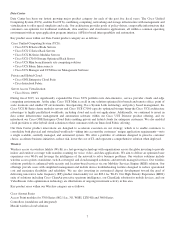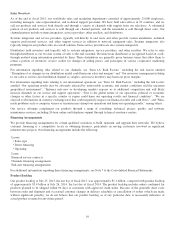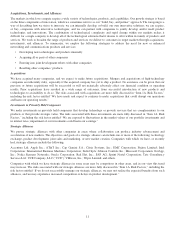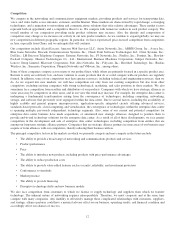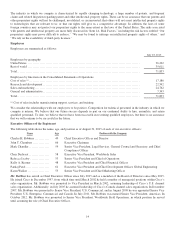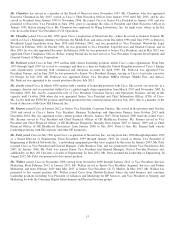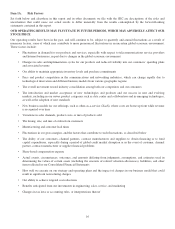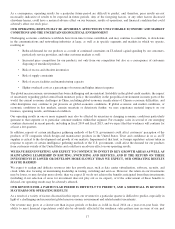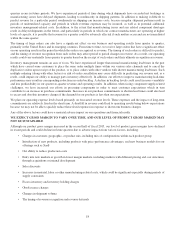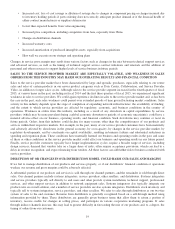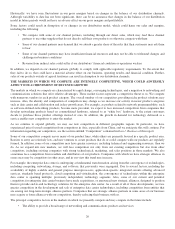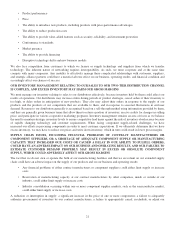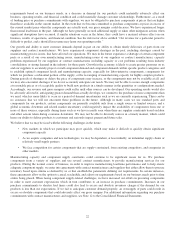Cisco 2015 Annual Report Download - page 20
Download and view the complete annual report
Please find page 20 of the 2015 Cisco annual report below. You can navigate through the pages in the report by either clicking on the pages listed below, or by using the keyword search tool below to find specific information within the annual report.Competition
We compete in the networking and communications equipment markets, providing products and services for transporting data,
voice, and video traffic across intranets, extranets, and the Internet. These markets are characterized by rapid change, converging
technologies, and a migration to networking and communications solutions that offer relative advantages. These market factors
represent both an opportunity and a competitive threat to us. We compete with numerous vendors in each product category. The
overall number of our competitors providing niche product solutions may increase. Also, the identity and composition of
competitors may change as we increase our activity in our new product markets. As we continue to expand globally, we may see
new competition in different geographic regions. In particular, we have experienced price-focused competition from competitors
in Asia, especially from China, and we anticipate this will continue.
Our competitors include Alcatel-Lucent; Amazon Web Services LLC; Arista Networks, Inc.; ARRIS Group, Inc.; Avaya Inc.;
Blue Jeans Networks, Brocade Communications Systems, Inc.; Check Point Software Technologies Ltd.; Citrix Systems, Inc.;
Dell Inc.; LM Ericsson Telephone Company; Extreme Networks, Inc.; F5 Networks, Inc.; FireEye, Inc.; Fortinet, Inc.; Hewlett-
Packard Company; Huawei Technologies Co., Ltd.; International Business Machines Corporation; Juniper Networks, Inc.;
Lenovo Group Limited; Microsoft Corporation; Palo Alto Networks, Inc.; Polycom, Inc.; Riverbed Technology, Inc.; Ruckus
Wireless, Inc.; Symantec Corporation; Ubiquiti Networks and VMware, Inc.; among others.
Some of these companies compete across many of our product lines, while others are primarily focused in a specific product area.
Barriers to entry are relatively low, and new ventures to create products that do or could compete with our products are regularly
formed. In addition, some of our competitors may have greater resources, including technical and engineering resources, than we
do. As we expand into new markets, we will face competition not only from our existing competitors but also from other
competitors, including existing companies with strong technological, marketing, and sales positions in those markets. We also
sometimes face competition from resellers and distributors of our products. Companies with which we have strategic alliances in
some areas may be competitors in other areas, and in our view this trend may increase. For example, the enterprise data center is
undergoing a fundamental transformation arising from the convergence of technologies, including computing, networking,
storage, and software, that previously were segregated within the data center. Due to several factors, including the availability of
highly scalable and general purpose microprocessors, application-specific integrated circuits offering advanced services,
standards-based protocols, cloud computing, and virtualization, the convergence of technologies within the enterprise data center
is spanning multiple, previously independent, technology segments. Also, some of our current and potential competitors for
enterprise data center business have made acquisitions, or announced new strategic alliances, designed to position them to
provide end-to-end technology solutions for the enterprise data center. As a result of all of these developments, we face greater
competition in the development and sale of enterprise data center technologies, including competition from entities that are
among our long-term strategic alliance partners. Companies that are strategic alliance partners in some areas of our business may
acquire or form alliances with our competitors, thereby reducing their business with us.
The principal competitive factors in the markets in which we presently compete and may compete in the future include:
• The ability to provide a broad range of networking and communications products and services
• Product performance
• Price
• The ability to introduce new products, including products with price-performance advantages
• The ability to reduce production costs
• The ability to provide value-added features such as security, reliability, and investment protection
• Conformance to standards
• Market presence
• The ability to provide financing
• Disruptive technology shifts and new business models
We also face competition from customers to which we license or supply technology and suppliers from which we transfer
technology. The inherent nature of networking requires interoperability. Therefore, we must cooperate and at the same time
compete with many companies. Any inability to effectively manage these complicated relationships with customers, suppliers,
and strategic alliance partners could have a material adverse effect on our business, operating results, and financial condition and
accordingly affect our chances of success.
12


